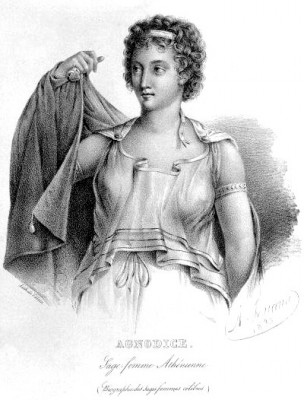 Women doctors in Greece, Rome, and the Byzantine Empire
Women doctors in Greece, Rome, and the Byzantine Empire
By Holt M. Parker
Women Physicians and Healers: Climbing a Long Hill, ed. Lilian R. Furst (University Press of Kentucky, 1997)
Introduction: Our sources for knowledge about women doctors in antiquity are fragmentary: a few passing mentions in classical authors, some scattered references in the medical writers, nearly forty inscriptions. We have no biographies, no details of their training, no specifics of their practice. Yet even from these fragments we can piece together some sort of picture, and the most important feature to emerge is simply that these women existed. The history of women as professionals in medicine does not begin in America in 1849 with Dr. Elizabeth Blackwell (1821-1910), the first woman to earn an M.D. in modern times; nor in Naples in 1422, with Costanza Calenda, the first woman we know of to receive a doctorate in medicine from a university; nor in Naples in 1321, with Francesca de Romana, the earliest woman we currently know to have been licensed to practice medicine generally; nor in Catania in 1276, with Virdimura, a Jew and wife of a Doctor Pasquale, who was licensed to practice on paupers, but extends back to at least the fifth century B.C. in Greece.
Second, the very nature of the evidence tells us something. There is no list of women doctors from antiquity, no direct comment on their existence as a class. The very scattering of the facts shows that the Greeks and Romans did not consider the presence of women doctors to be in itself remarkable. Women physicians, though undoubtedly only a small percentage of the medical personnel, were an everyday part of the ancient world. This is shown clearly by the earliest source attesting to the existence of women doctors in Greece. Plato, in the Republic. whose fictional date is around 421 BC, argues that for the good of the state jobs should be assigned to people on the basis of natural aptitude. There may be physical differences between individuals, but they should be ignored if they are irrelevant to carrying out the proper functions. Thus a bald mall and a long-haired man can be equally competent cobblers. The only important differences are those of the soul or mind. Plato then goes on to make a radical proposal: since the soul has no sex, in theory at least, some women may be found who would be suitable for most difficult job of all, that of the guardian who rules the state. To support his argument, he uses the following example: So we meant that a man skilled in medicine (iatrikos) and a woman skilled in medicine (iatrike) – in respect of their minds – have the same nature, and a few paragraphs later: As we said, one woman is skilled in medicine (iatrike), another is not; one is skilled in music by nature, another is not.


 It is important to note here that Plato is not arguing for the existence of women doctors, nor hoping to convince people that there ought to be women doctors. Rather, he is supporting his argument, almost in passing, for the role of women in the ideal state by pointing to something everyone could already see in the current state – that there were female doctors as well as male. Pomeroy summarizes “Plato did not have to prove women’s aptitude for the medical profession. On the contrary, his case rests on the actual existence of female physicians in the Athens of his own day, when the profession of physician was the only occupation available to women that was respectable and yet not banausic, and that required advanced formal education.”
It is important to note here that Plato is not arguing for the existence of women doctors, nor hoping to convince people that there ought to be women doctors. Rather, he is supporting his argument, almost in passing, for the role of women in the ideal state by pointing to something everyone could already see in the current state – that there were female doctors as well as male. Pomeroy summarizes “Plato did not have to prove women’s aptitude for the medical profession. On the contrary, his case rests on the actual existence of female physicians in the Athens of his own day, when the profession of physician was the only occupation available to women that was respectable and yet not banausic, and that required advanced formal education.”
Click here to read this article from Academia.edu
Sponsored Content


By Holt M. Parker
Women Physicians and Healers: Climbing a Long Hill, ed. Lilian R. Furst (University Press of Kentucky, 1997)
Introduction: Our sources for knowledge about women doctors in antiquity are fragmentary: a few passing mentions in classical authors, some scattered references in the medical writers, nearly forty inscriptions. We have no biographies, no details of their training, no specifics of their practice. Yet even from these fragments we can piece together some sort of picture, and the most important feature to emerge is simply that these women existed. The history of women as professionals in medicine does not begin in America in 1849 with Dr. Elizabeth Blackwell (1821-1910), the first woman to earn an M.D. in modern times; nor in Naples in 1422, with Costanza Calenda, the first woman we know of to receive a doctorate in medicine from a university; nor in Naples in 1321, with Francesca de Romana, the earliest woman we currently know to have been licensed to practice medicine generally; nor in Catania in 1276, with Virdimura, a Jew and wife of a Doctor Pasquale, who was licensed to practice on paupers, but extends back to at least the fifth century B.C. in Greece.
Second, the very nature of the evidence tells us something. There is no list of women doctors from antiquity, no direct comment on their existence as a class. The very scattering of the facts shows that the Greeks and Romans did not consider the presence of women doctors to be in itself remarkable. Women physicians, though undoubtedly only a small percentage of the medical personnel, were an everyday part of the ancient world. This is shown clearly by the earliest source attesting to the existence of women doctors in Greece. Plato, in the Republic. whose fictional date is around 421 BC, argues that for the good of the state jobs should be assigned to people on the basis of natural aptitude. There may be physical differences between individuals, but they should be ignored if they are irrelevant to carrying out the proper functions. Thus a bald mall and a long-haired man can be equally competent cobblers. The only important differences are those of the soul or mind. Plato then goes on to make a radical proposal: since the soul has no sex, in theory at least, some women may be found who would be suitable for most difficult job of all, that of the guardian who rules the state. To support his argument, he uses the following example: So we meant that a man skilled in medicine (iatrikos) and a woman skilled in medicine (iatrike) – in respect of their minds – have the same nature, and a few paragraphs later: As we said, one woman is skilled in medicine (iatrike), another is not; one is skilled in music by nature, another is not.
Click here to read this article from Academia.edu
Sponsored Content